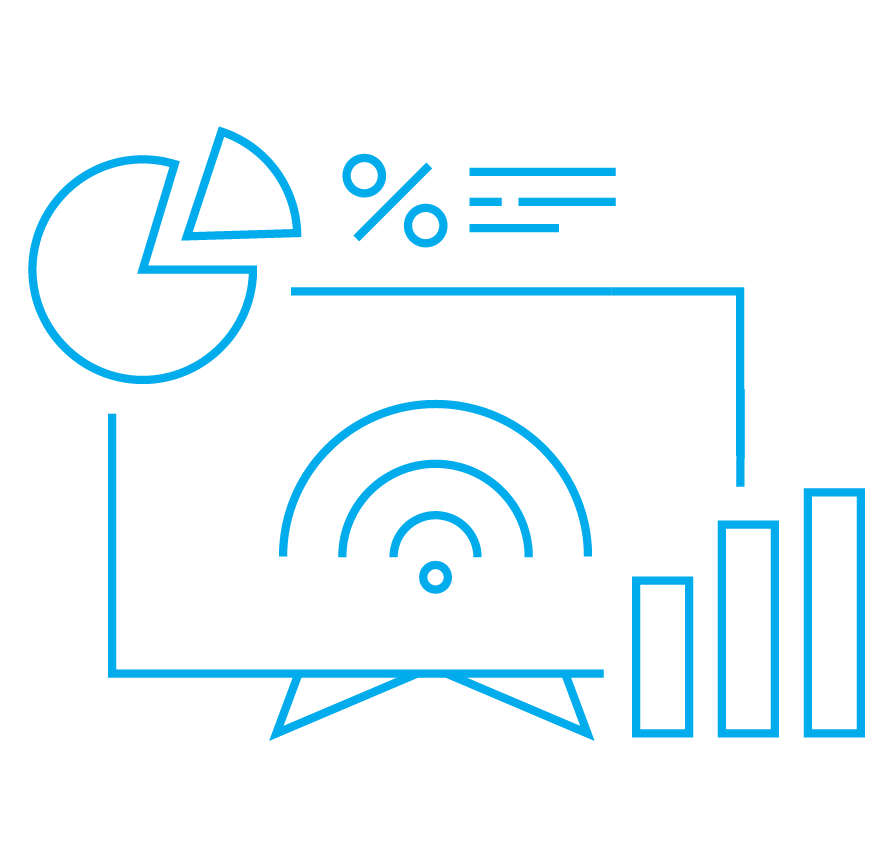- What is mobile advertising and how does it work?
- Mobile data is a source for the mobile advertising campaign
- Mobile advertising measure methods
- Mobile advertising benefits
- Conclusions
[scrollHeadline headlines=”what-is-mobile-advertising,mobile-data,mobile-ads-measure-methods,mobile-ads-benefits” titles=”What is mobile advertising and how does it work?,Mobile data is a source for the mobile advertising campaign,Mobile advertising measure methods,Mobile advertising benefits”]
63% of all digital ad spendings in the US belong to mobile’s share, IAB reports. From all of the mobile ad channels, the market members point a video channel as the most effective one. Moreover, eMarketer says that a big part of ad spends (87%) was directed to mobile programmatic video ads from total mobile video ad spending in 2019. This proves that marketers rely on mobile advertising technologies to promote their products online now more than ever before. As people tend to spend more time with their smartphones, the advertising market tailors its techniques to allow building a personalized targeting campaign and intelligently reach a given target audience on any place on earth.
Martechseries reports, the mobile video brings significant performance with 10x higher CTRs than banners, and 2x higher than native. Statistically, native ads work better in terms of user engagement than classic banners. It is certainly a high impact opportunity for advertisers. Research companies predict that together with the fastest 5G network, the market technologies will raise a bar of mobile advertising efficiency.
What is mobile advertising and how does it work?
Mobile advertising offers to reach your customers via their smartphones. This is not just about to optimize desktop ad version in terms of mobile screen resolution, it is much complicated. Marketers have to choose the best display ad channel for their mobile campaign, as there is plenty of possibilities to pick:
- video,
- gamified ad,
- in-app,
- native,
- classic banners.
An effective advertising campaign brings the most relevant audience data and the best ad type to get the highest ROI.
Programmatic advertising model takes a leading position in the marketing market worldwide as it automates buying and selling actions during an advertising campaign. 83.5% of US digital ad spends are transacted using programmatic technology today. This year, $46.86 billion, or 88.7% will be spent on digital mobile campaigns in the programmatic model, eMarketer reports.
‘Mobile advertising is growing fast, not only on the US market, where almost two-thirds of programmatic spendings go to mobile.
Advertisers willingly invest in this channel because it is based on MAIDs (Mobile Advertising IDs) which are pretty stable and not that much time sensitive as cookies are.Another factor that will help boost expenditures is the super-fast 5G network. It’ll allow marketers to easily deliver high-quality video ads, on which marketers will spend almost $25 billion this year, according to eMarketer. If we take a look at our DMP, we can see that almost 40% of audience data is mobile and this trend is rapidly rising.’
Maciej Sawa, CEO OnAudience.com
The US marketing market is the largest worldwide, US marketers were first who started to use the programmatic model within targeting campaigns and first who earned profits out of it.
What is programmatic model? The parties that participate in the programmatic buying process are responsible for each of advertiser / publisher roles. Real-Time Bidding (RTB) as the most popular automated technique, is based on a work of Supply-Side Platform (SSP) by the publisher’s side and Demand Side Platform (DSP) by advertiser’s.
Both platforms are connected with ad exchange and a data provider (e.g., Data Management Platform), which delivers audience mobile data. Working simultaneously, they enable sending bid requests per individual user and buying ad inventory in real-time. Check our infographics with programmatic advertising and direct buying comparison.
Mobile data is a source for the mobile advertising campaign
Together with mobile advertising efficiency grows the demand for trustworthy sources of mobile data. Mobile data is a set of information with detailed characteristics per a particular user from your target or possible audience. Technically speaking, mobile data delivers such information, as user’s:
- application,
- device,
- operating system,
- IP,
- action timestamp,
- chosen interface language,
- geolocation.
All the information is properly encoded by DMP machine algorithms where data is collected.
How mobile data is delivered?
There are two ways available for mobile data delivery. It’s either through the DSP by buying particular segments or in terms of Mobile App Data Stream of customized audience data.
1. DSP offers access to a bunch of created segments worldwide. Those segments correspond with chosen audience characteristics based on your targeting campaign brief. They are also shared between other DSP partners so they are bought in a read-only mode. It means that buying a segment, you can’t edit it in terms of your business need, but just activate it in your platform and receive a portion of mobile data about your target audience.
2. As an alternative, you have Mobile Data Stream that offers choosing dedicated user-profiles, modify it or create a segment from scratch with your own taxonomy. Mobile data is a part of the daily raw data feed, known as a part of Data Stream service, offered by OnAudience.com. Raw data allows filling the gaps in user profiles within your CRM system, building new tools and advanced analysis methods.
Mobile advertising measure methods
Available measure methods show the actual efficiency of the mobile campaign. It can be represented in Click-Through Rate (CTR), which refers to the number of clicks on a particular link. As there is a possibility to tap on the screen accidentally, the digital experts advise applying Secondary Action Rate (SAR) which calculates a number of secondary actions, as the name suggests. This proves actually that the user’s click was intentional so the measured value is reliable.
‘When looking at internet usage, the majority of time is spent on the mobile device. When looking at the mobile internet usage behaviour, the majority of time is spent in-app.
Under in-app advertising we differentiate between Audience Targeting and Proximity Targeting. The former helps to build brand awareness. The underlying app behavioural, deterministic demographic and/or geo-behavioural data is connected to users’ Mobile Advertising IDs. The latter is especially designed to boost drive-to-store campaigns and increase sales. Users can be reached based on their location in the moment of ad impression in real-time.
Especially with the latest announcement from Google about the phase out of third party cookies, advertisers are well advised to embrace the in-app targeting capabilities.Mobile data doesn’t only help you to target the right audience at the right time. In addition, it helps to answer the most important question in advertising: does your ad spend achieve the results you need?
For a more complete approach to campaign performance measurement, you need to be able to attribute store visits to your advertising efforts. And for this, no approach is more effective than footfall measurement. With the right location data, processed correctly and applied to the right performance measurement model, footfall data can provide advertisers with the information they need to optimise their campaigns.’
Christoph Herwig, VP Marketing at adsquare
There are more ways to track your mobile ad engagement rate. Depending on your business case, you can use also one of those:
- Cost per Impression (CPI) – cost for every new ad view.
- Cost per Action (CPA) – for every completed action.
- Cost per View (CPV) – for every advertisement’s pop up.
- Cost per Mile (CPM) – for every thousand ad views.
- Conversion Rate (CR) – percentage of users taking the desired action.
- Install Rate (IR) – percentage of users installing an app.
Mobile advertising benefits
A successful mobile advertising campaign brings plenty of advantages. There is a reason why 63% of ad spends were directed to mobile digital ads last year, and they are not going to slow down. We have 5 the most important benefits described:
1. Large range & geolocalization
First and the most obvious benefit is a big scope of advertising reach that you can gain out of your mobile advertising campaign. For example, if you’re an owner of the local store, you can set to show the ads to those users who are currently in your neighborhood. Moreover, you can see what exactly the user was looking for to show the ads of the most relevant product for him. This will raise the possibility that your target user will stop by to your store. On the other side, it’s also helpful for the person, who is new in town. It saves time and simplifies the searching. With programmatic technology, the whole process of reaching user happens automatically.
2. Data integration & finding new clients
If you have an online business, you can integrate with your in-app partner and receive a mobile dataset about their users, of course with their consent being received. This data can be involved in your campaign as the basis for a brief. This way you can increase your customer network and find new clients.
3. Respecting mobile users’ privacy
The biggest difference between mobile and desktop data is involved here. Desktop data is yet collected via the users’ cookie file, which raises big privacy concerns now so the modern browsers are turning their support off. The big discussion is raised around this topic with alternatives to how marketers can assure the users’ privacy now. In a matter of privacy, mobile data is a lot safer. Mobile data collecting doesn’t involve the cookie files, instead, an algorithm uses Mobile Advertising ID (on smartphones with Android OS installed) or Application ID (with iOS installed). These IDs are used for the matching process by the data providers where mobile data is delivered.
4. High effectiveness of mobile video
The most successful display channel now, video, is also one of the biggest mobile advertising benefits. A short and informative video can motivate people to click on the ads and raise conversion rate significantly. Mobile video is delivering 80% video completion rates and 91% viewability.
5. Easy payments method
Another mobile ads benefit is the ability to pay instantly. Developed technologies allow now to pin a payment card to the phone wallet so that money transfer happens within a few seconds. This is a lot faster than money transfers through a laptop.
Conclusions
We have strong predictions that mobile advertising will be leading this year as well as the next few years, as from the screen channels smartphones are definitely winning comparing with desktop and TV.
Use the benefits of mobile advertising fully by creating a successful mobile advertising campaign. Pick the most powerful display ad channel that suits your business needs and gain profits.




